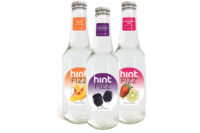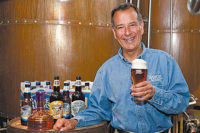![]()
Savor the Flavor
Beverage-makers use flavors to enhance consumer appeal
by Jennifer Korolishi
Adding a hint of lime, a pinch of pomegranate or a burst of berry can
make an ordinary beverage stand out from the crowd. As beverage-makers
search for new points of product differentiation, flavors are playing
an increasingly important role.
Beverage flavor selection is typically influenced by
both technical and marketing considerations. Beverage-makers choose from
three main flavor options: natural flavors, including red/dark fruit
flavors like strawberry, and citrus flavors including lemon, lime, orange
and grapefruit; artificial flavors, which mimic natural flavors but are
created through artificial means; and natural- and-artificial flavors, a
blend of the two types. While the popularity of coffee drinks has prompted
a rise in the use of chocolate, coffee and cocoa flavors, fruit and citrus
flavors remain industry mainstays.
“It’s pretty open today —
we’re seeing beverage-makers using every type of flavor,” says
Joe Minella, beverage applications manager for Virginia Dare, a Brooklyn,
N.Y., flavor manufacturer known for high-quality vanilla and teas.
“That includes either single or blended flavors, tropical flavors,
and now with the popularity of cappuccino-type drinks, you see more caramel
and dulce de leche flavors.”
In the United States, the Food and Drug Administration
governs what is considered to be a “natural” flavor.
Additionally, flavors must meet guidelines set by the Flavor and Extract
Manufacturers Association (FEMA). FEMA’s expert panels offer guidance
on allowable flavoring materials.
A natural or artificial designation is determined by
how the flavor materials are sourced. Natural flavors are sourced from
natural materials by extraction or other means, whereas artificial flavors are typically synthesized in a laboratory. The
way in which ingredients are mixed and blended also contributes to a
flavor’s designation. Beverage-makers must consider where the
beverage is marketed as well, since countries often define
“natural” flavors differently.
At Symrise Inc., Teterboro, N.J., a leader in
encapsulation, culinary solutions, citrus and mint flavors, R&D teams
work to generate new, unique materials — natural and artificial
— which then must be approved by a FEMA expert panel.
“Flavor companies either use those materials
internally or develop a marketing plan to sell those materials,” says
John Cavallo, senior vice president for global beverages at Symrise.
“With the more unique materials, typically a flavor company will hold
such materials captive to develop flavors that will give them a point of
difference in the marketplace.” That point of difference could lie in
a number of areas, including flavor profile, sensate effects or a stability
difference.
Natural flavors dominate the U.S. beverage market;
Cavallo estimates that 90 percent of the market uses natural flavors.
“That number is high primarily because, if you
look at the breakout of citrus flavor usage in beverages, it’s
somewhere between 50 and 60 percent,” says Cavallo. “The
typical cola is compounded with many citrus materials, and with cola being
such a big factor in the marketplace, it drives the importance of citrus as
a total category significantly higher.”
While most domestic Virginia Dare customers seek out natural flavors, overseas beverage-makers
use artificial flavors more frequently.
“A lot of it has to do with cost.
Beverage-makers want to keep the cost down and the artificial and
natural-and-artificials are less expensive flavors,” Minella says.
“You get the same profile, but it’s different on your
label.”
Natural flavors also tend to be preferred in the
United States for labeling reasons, since the word “natural” is
a powerful marketing tool. Beverage-makers may use a “natural
flavors” label claim if the flavor contains a compound that is
identified in nature and isolated from nature or is synthesized naturally.
“Natural flavors are much preferred over
natural-and-artificial flavors because consumers associate
‘natural’ as ‘better for you,’” says Gary
Raab, head of the flavor creation team at Wild Flavors Inc., Erlanger, Ky.,
a manufacturer of beverage flavors. “When combined with
nutraceuticals and fortification, it’s a win-win situation.”
Choosing a flavor has other technical considerations,
as well. “Certain flavoring systems, such as citrus, are susceptible
to off-note development or instability, which can be generated through
interactions with light or air, or could be catalyzed by interactions in
low-pH systems or high-acid environments,” says Cavallo.
Minella adds, “Citrus flavors have a shorter
shelf life than berry flavors — they tend to oxidize quicker, and it
depends on what’s in there as far as adding a lot of vitamins and
minerals, which might react with some flavors more than others.”
Most flavors, however, are chosen primarily on the
basis of appeal to the end consumer. “If you’re going with a
natural, 100 percent juice, then they’ll use natural flavor. If
you’re doing a bellywash, or an all-sugar, artificial-color type
beverage, they’ll use artificial flavor. It really runs according to
the finished product and what the customer is looking to bring out on the market,” says Minella.
Consumer trends & future flavors
Consumer trends directly affect the flavors that appear
in beverages, with demographics playing a critical role; as the U.S.
population shifts, niche consumer preferences often become more mainstream.
“One very important factor is the growing
Hispanic population, which is really a tremendous change, with 77 percent
growth of that population in the past 12 years, according to the U.S.
Census Bureau,” says Symrise Marketing Manager Emmanuel Laroche.
“It’s very important for the beverage manufacturer to
understand the expectations of that population segment.”
To appeal to the growing Hispanic population,
beverage-makers are incorporating more tropical fruits into their products,
specifically mango, guava and papaya, which are popular in Mexico, Central
America and the Caribbean. These fruits are being used both as stand-alone
flavors and in blends with more traditional citrus flavors.
Symrise conducted a nationwide online consumer survey
to identify the next generation of flavors appealing to the Hispanic
population.
“We found that the Hispanic population is very
interested in pineapple, either stand-alone or in combination with orange,
as well as pink grapefruit and kiwi, primarily in combination with fruits
like watermelon,” Laroche says.
Concern about obesity in the United States is also
prompting beverage companies to re-examine formulations. As a result,
Laroche says, more nutritional and functional beverages will likely debut
in the coming years.
“When beverage companies are looking into
launching healthy products, they have to have a taste that is in synch with
the concept,” says Laroche. “That’s why you see a lot of
popularity right now with green tea and white tea, as well as pomegranate,
which has been recently found to contain a higher antioxidant level.”
Virginia Dare has also seen an upswing in interest in
pomegranate and plans to feature a pomegranate tea at this month’s
IFT show. “Because it’s considered a healthy fruit,
beverage-makers might use pomegranate juice to make a healthy product
rather than a cherry or raspberry flavor,” says Minella.
“However, often with healthy beverages, flavor is not the primary
concern. It’s more about what’s actually in the product, what
they fortify it with and what type of juices or sugars are used.”
With health concerns becoming more prominent, fortified
drinks and breakfast drinks are gaining popularity as meal replacements.
Minella also says the current low-carb craze is working its way into beverages.
“Beverage-makers are trying to go low-carb with
less sugar, but with the same flavor profiles,”
says Minella. “It doesn’t affect the flavor too much. You might
have to adjust the dosage or increase the intensity, but generally most
flavors will work in those different systems.”
In terms of additional healthy beverage trends, Raab
notes, “With the surge of products containing soy protein, the
ability to provide ‘protein-stable’ true-to-fruit flavors and
quality indulgent flavors will be critical. The same rings true with the
flavors required in beverages that combine fruit juice and dairy now
hitting the marketplace. However, exotic fruit blends, which are light and
refreshing, will continue to be the trend for enhanced waters and energy
drinks.”
Outside of the sphere of social influence and health
concerns, taste combinations remain popular with American consumers. While
single-note flavors continue their prevalence, combinations —
particularly those based on a widely used flavor like orange or lemon
— are growing. Also showing growth are bolder, more intense flavors,
particularly in beverages geared toward children and teenagers.
“We have seen recently a lot of development with
sour and acid notes that were always very popular on the confectionery
side, but now have been transferred into the beverage industry,”
Laroche says.
And even tried and true soft drinks are getting into
the flavor act, with the recent rollout of Diet Coke with Lime, in an
effort to breathe new life into a traditional product. “Citrus works
well in a lot of these type of products and the lime, lemon and orange
flavors always carry pretty nicely through it, so you’ll see them in
a lot of products,” says Minella.

